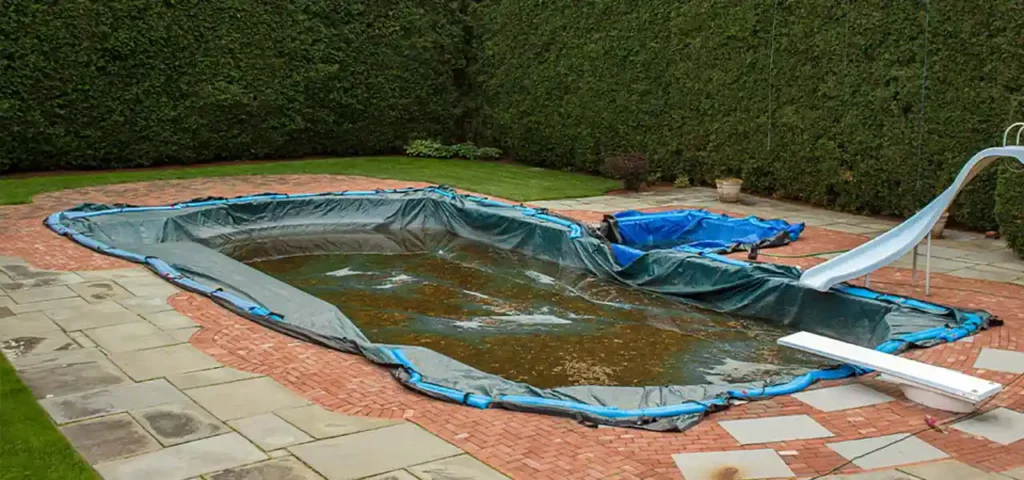Diving into the Health Risks of Swimming Pool Covers: What You Need to Know
Swimming pools are synonymous with summer fun and relaxation. However, beneath the shimmering surface lies a potential health concern that often goes overlooked – swimming pool covers. While these covers are said to protect the pool and conserve water, they mainly harbor health risks that deserve our attention. In fact, we think it’s better for your pool in the long run to not cover your pool at all.
In this article, we’ll explore the health risks associated with swimming pool covers and discover the steps we can take to mitigate these hazards.
What about the safety risks of pool covers? Learn More About those Here
1. Pool Covers Cause Mold and Bacteria Buildup
One of the primary health risks of pool covers is the potential for mold and bacteria buildup. When a pool cover is used to protect the water from debris, leaves, and rain, it also creates a dark and damp environment perfect for mold and bacteria to thrive. As water evaporates, it gets trapped beneath the cover, leading to moisture accumulation. This can result in the growth of harmful microorganisms, including mold, mildew, and various bacteria strains, such as E. coli and Legionella.
Respiratory Issues
The presence of mold and bacteria in the air around the pool area can pose serious respiratory risks, especially for individuals with allergies, asthma, or weakened immune systems. When swimmers remove the cover, the disturbed spores and particles can become airborne, potentially causing allergic reactions or respiratory issues. Pool owners and users should be cautious about inhaling these contaminants and ensure proper ventilation and sanitation measures to minimize the risk.
Skin Irritations
In addition to respiratory risks, exposure to mold and bacteria can also lead to skin irritations and infections. Coming into direct contact with contaminated water or surfaces may cause skin rashes, itching, or even more severe skin infections. Even during the fall and winter months, with roper pool maintenance, including regular water testing and adequate chlorination, you can keep your pool open and prevent such issues.

2. Tripping and Falling on Pool Covers
Beyond the health concerns tied to mold and bacteria, pool covers can also pose physical risks. When not properly secured or maintained, covers can become loose or torn, creating tripping hazards for pool users. Slips and falls can result in injuries ranging from minor bruises to more severe fractures, concussions, or even drowning if someone falls into the water unexpectedly. Keeping your pool open year round, prevents someone from falling and getting trapped in the pool cover.
RELATED: Check out our article on Safety Risks of Pool Covers to Avoid
3. Pool Covers Are A Breeding Ground for Mosquito’s and Insects
Stagnant water on the pool cover can attract mosquitoes and become a breeding ground for these disease-carrying insects. Mosquitoes are notorious disease carriers, capable of transmitting various illnesses to humans and animals. Pool covers that collect rainwater and moisture provide the ideal environment for female mosquitoes to lay their eggs, leading to a rapid increase in their population.
The presence of mosquitoes from a pool cover can pose significant health risks, as these insects are known carriers of diseases such as West Nile virus, dengue fever, Zika virus, and chikungunya. When left unchecked, a mosquito breeding ground on a pool cover can contribute to the spread of these potentially serious and even life-threatening diseases.
4. Pool Covers Harbor Contamination from Wildlife
Another important health risk associated with swimming pool covers is contamination caused by critters and wildlife. During colder months or when the pool is not in use, small critters such as rodents, insects, frogs, and even birds might seek shelter on or under the pool cover. Their presence can lead to various issues that can impact pool water quality and potentially pose health risks.
Droppings and Debris
Wildlife droppings, feathers, and other debris that accumulate on the pool cover can easily find their way into the water when the cover is removed. This contamination can lead to unsightly and unhygienic pool conditions.
Bacteria and Pathogens
Wildlife carries various bacteria and pathogens in their feces, which can be introduced into the pool water. Exposure to these contaminants can lead to gastrointestinal issues and other health problems.
Algae Growth
If wildlife brings in plant materials or algae spores, they can contribute to the growth of algae in the pool water when the cover is removed.
Clogged Pool Equipment
The debris brought in by wildlife can clog pool equipment, including filters and pumps, leading to reduced efficiency and potential breakdowns.

5. The Decomposition of Debris on Pool Covers
another important health risk associated with swimming pool covers – the decomposition of debris. Leaves, twigs, and other organic matter that collect on the pool cover can gradually break down and decompose, releasing organic compounds into the pool water. This decomposition process can have several adverse effects on pool water quality and potentially lead to health issues for swimmers.
Organic Compounds
As the debris decomposes, it releases organic compounds, including tannins and humic acids, into the pool water. These compounds can give the water a yellow or brownish tint, negatively affecting its appearance.
Algae Growth
The organic matter from decomposing debris serves as a food source for algae. This can lead to accelerated algae growth in the pool water, turning it green and creating an unsightly swimming environment.
Reduced Chlorine Effectiveness
Organic compounds from debris can bind with chlorine in the water, reducing its effectiveness as a disinfectant. This can lead to inadequate sanitation and an increased risk of waterborne illnesses.
Foul Odors
Decomposing debris can also produce foul odors, making the pool area less pleasant for swimmers and bystanders.
Preventing Health Risks Associated with Swimming Pool Covers
While swimming pool covers some benefits, ultimately, it’s not the best thing to keep on your pool during the fall or winter season. In fact, 100% of our pool maintenance clients keep their swimming pools open year round. This allows you to prioritize safety and take appropriate precautions to minimize potential health risks. Here are some steps our pool maintenance clients take:
1. Keep your pool open year round.
It’s actually more cost effective if you consider both the costs of pool closure and opening as well as the costly repairs that can come from not running your pool and keeping the equipment and plumbing active.
2. Perform weekly pool cleaning and maintenance.
Since the pool is kept open year round, we provide weekly pool cleaning which prevents mold and bacteria buildup.
3. Proper chemical management to ensure proper water quality.
We ensure that your pools chemicals are checked and balanced each week to ensure proper water quality which significantly prevents the spread of bacteria and infections.
4. Provide proper supervision of children and pets.
Never leave children or pets unattended around the pool, whether it’s covered or not.
Conclusion
Swimming pool covers offer practical benefits but must be used with caution to avoid health risks. By understanding and mitigating these potential hazards, we can continue to enjoy the pleasures of swimming while ensuring the safety and well-being of ourselves and others. Let’s dive into a summer of fun with pool safety at the forefront of our minds!


